page 8
(The Study of Threes)
http://threesology.org
Visitors as of 11/18/2019
| Pages in the Biological & Physiological 3s Series: | ||
| B/P 3s pg. 1 | B/P 3s pg. 2 | B/P 3s pg. 3 |
| B/P 3s pg. 4 | B/P 3s pg. 5 | B/P 3s pg. 6 |
| B/P 3s pg. 7 | B/P 3s pg. 8 | B/P 3s pg. 9 |
| B/P 3s pg. 10 | B/P 3s pg. 11 | The Devil's Advocate and 3s Research |
The complex arrangements of macromolecules in the virus shell are mi-nute marvels of molecular architecture. Specific requirements of each type of virus have resulted in a fascinating apparent diversity of organization and geometrical design. Nevertheless, there are certain common features and general principles of architecture that apply to all viruses.
In 1956, Crick and Watson proposed on theoretical considerations and on the basis of rather flimsy experimental evidence then available, principles of virus structure that have been amply confirmed and universally accepted.
They first pointed out that the nucleic acid in small virions was probably insufficient to code for more than a few sorts of protein molecules of limited size. The only reasonable way to build a protein shell, therefore, was to use the same type of molecule over and over again, hence their theory of identical subunits.
The second part of their proposal concerned the way in which the subunits must be packed in the protein shell or capsid. On general grounds it was expected that subunits would be packed so as to provide each with an identical environment. This is possible only if they are packed symmetrically. Crick and Watson pointed out that the only way to provide each subunit with an identical environment was by packing them to fit some form of CUBIC SYMMETRY. A body with cubic symmetry possesses a number of axes about which it may be rotated to give a number of identical appearances. These predictions were soon confirmed and it became evident that the occurrence of icosahedral features in quite unrelated viruses was not a matter of chance selection but that icosahedral symmetry is preferred in virus structure.
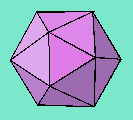
is composed of 20 facets, each an equilateral triangle, and 12 vertices, and
because of the axes of rotational symmetry, is said to have
(a
three-patterned) 5:3:2 symmetry:
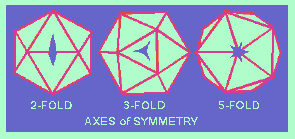
There are, in fact:
- (1) Six 5-fold axes passing through the vertices.
- (2) Ten 3-fold axes extending through each face.
- (3) Fifteen 2-fold axes passing through the edges of an icosahedron.
Icosahedral symmetry requires definite numbers of structure units to complete a shell. In their discussions, Crick and Watson (1956), thinking in terms of asymmetrical protein subunits packed in such a way that each has an identical environment, pointed out that a virus with 5:3:2 symmetry required a multiple of 60 subunits to cover the surface completely. Each unit would be related identically and asymmetrically with its neighbours, and none of the units would coincide with an axis of symmetry.
The theoretical basis for the structure of isometric viruses was put on a firm foundation by Caspar and Klug (1962) with their concept of identical elements in quasi-equivalent environments. They defined all possible polyhedra in terms of structure units.
The icosahedron itself has 20 equilateral triangular facets and therefore 20T structure units:
where T is the TRIANGULATION NUMBER given by the rule:
where P can be any number of the series 1,3,7,13,19,21,31 ...(=h2 + hK +K2, for all pairs of integers, h and K having no common factor)
and f is any integer.
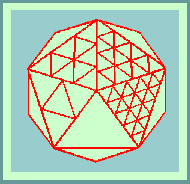
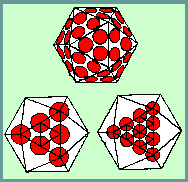
Morphological units can be clustered as 20T trimers, 30T dimers or separated as 60T monomers. The number of morphological units that would be produced by a clustering into hexamers and pentamers can be calculated as follows: There are 10(T-1) hexamers plus 12. (and only 12) pentamers.
Caspar and Klug (1962) claimed that most icosahedral viruses fall into 2 classes:- P = 1 and P = 3; and that all deltahedra for which P = >7 are skew, and therefore exist in right and left- handed forms. One "hand" might be selected by the nucleic acid, but there would still be the chance that mistakes in assembly leading to defective particles might occur. The most probable mistake in assembly would be the formation of tubular forms. Tubular structures which have a diameter and surface structure similar to icosahedral virus particles have been observed associated with polyoma and papilloma viruses.
In a review of symmetry in virus architecture, Horne and Wildy (1961) showed that all the viruses then known (with the exception of a few bacteriophages) fell into two main morphological groups:
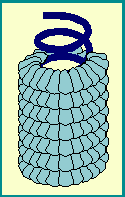 Those with cubic symmetry and the others with HELICAL symmetry.
Those with cubic symmetry and the others with HELICAL symmetry."Linear" viral capsids have RNA genomes that are encased in a helix of identical protein subunits.
The length of the helical viral nucleocapsid is determined by the length of the
nucleic acid. Until 1960, the only known examples of virions with helical symmetry were
those of plant viruses,
the best studied example being tobacco mosaic
virus.
3 types of benign headaches associated with sexual activities are:
- Dull type: a dull ache in the head and neck that intensifies as sexual excitement increases.
- Explosive type: a sudden severe ("explosive") headache occurring at or seconds before orgasm.
- Postural type: Postural headache resembling that of low CSF pressure headache.
3 to 1 ratio of causes to the development of most peptic ulcers:
- 1 of 3. Bacteria in the stomach (Helicobacter pylori) - very common>
- 2 of 3. The use of anti-rheumatic medicine, NSAIDs (or aspirin- less common)
- 3 of 3. Stomach cancer- rare (and never when the ulcer is in the duodenum)
- 1 of 1. There are other types of peptic ulcers but these are very rare.
| Acid pump inhibitors |
+ Antibiotic 1 | + Antibiotic 2 | Advantages | Disadvantages |
| Omeprazole 20 mg |
Amoxicillin 1000 mg |
Clarithromycin 500 mg | Treatment is
quick. Effective >90%. Few side effects. |
Cannot be
used when patient is allergic to penicillin. Chance of developing resistance to clarithromycin- like antibiotics. |
| Lansoprazole 30 mg |
Amoxicillin 1000 mg |
Clarithromycin 250 - 500 mg | ||
| Pantoprazole 40 mg |
Amoxicillin 1000 mg |
Clarithromycin 500 mg | ||
| Dosage: 1 of each 2 times daily for 7 days | ||||
| Omeprazole 20 mg | Metronidazole 400 mg |
Clarithromycin 250 mg | Treatment is quick. Effective >90%. Can be used when allergic to penicillin. |
Consumption of alcohol is not
advised during treatment. Metronidazole can cause nausea. Chance of developing resistance to clarithromycin -similar antibiotics. |
| Lansoprazole 30 mg | Metronidazole 400 mg |
Clarithromycin 250 - 500 mg | ||
| Pantoprazole 40 mg | Metronidazole 400 mg |
Clarithromycin 250 mg | ||
| Omeprazole 20 mg x2/day |
Amoxicillin 500 mg |
Metronidazole 400 mg x3/day |
||
| Dosage: For 7 days | ||||
| Lansoprazole 30 mg | Amoxicillin 1000 mg |
Metronidazole 400 mg |
It may be more effective. | Consumption of
alcohol is not advised during treatment. Metronidazole can cause nausea (3 x dose). More expensive than the others. |
| Dosage: 1 of each 2 times daily for 7 days | ||||
3 factors combine to regulate our metabolism: Nutrition ~ Glandular system ~ Nervous system
3 predominant basic metabolic types of the world's Population groups that developed over thousands of years, depending on their climate and available food:
- P-type in which the PNS (parasympathetic nervous system) dominates.
- S-type with a dominating SNS (sympathetic nervous system).
- A balanced type.
| S-type | Balanced- type | P-type |
| Tendency to raised blood pressure, fast pulse & breathing | Central tendency | Tendency to low blood pressure, slow pulse & breathing |
| Slender, slight body frame, narrow face, flat chest | Central tendency | Strong bone structure, broad face, rounded chest |
| Dry mouth, ears & gums pale, skin dry, yellowish | Central tendency | Much saliva, ears & gums pink, ruddy complexion, flushes |
| Weak dreaming activity | Central tendency | Much dreaming activity |
| Sprinter type, not much endurance, fitness fanatic | Central tendency | Long-distance runner, steady worker, good endurance |
| Appetite diminished, digestion slow & weak | Central tendency | Appetite above normal, digestion fast & strong |
| Enjoys fruits & vegetables, dislikes fatty food | Central tendency | Likes meat, starches & fatty food |
| Emotionally unstable, freely shows emotions | Central tendency | Emotionally stable, rarely shows emotions |
| Quick to make decisions | Central tendency | Slow to make decisions, cautious |
| Seldom sad, depressed, melancholic or withdrawn | Central tendency | Tendency to being sad, depressed, withdrawn, melancholic |
| Extroverted, easily angered or irritated | Central tendency | Introverted, rarely angered or irritated |
| Tense, lively, overactive, jumpy | Central tendency | Relaxed, quiet, slow or sluggish |
| Strongly assertive, aggressive | Central tendency | Non-assertive, non-aggressive |
| Hate, envy, verbal abuse | Central tendency | Resentment, guilt, worry, doubt |
| Slow Oxidisers | "Central Oxidisers" | Fast Oxidisers |
| Blood pressure raised or high | Central tendency | Blood pressure low |
| Often heavy body and hard manual worker | Central tendency | Often overweight or underweight & low in energy |
| Often too alkaline, insensitive to cold & skin irritants | Central tendency | Overacid, cold hands & feet, skin very sensitive |
| Enjoys meat & heavy food but also fruit & sour food | Central tendency | Craves sweet food but feels better after protein & salty food |
| Emotionally unresponsive, undemonstrative | Central tendency | Emotionally unstable, irritable, outbursts, shy, resentful |
| Rarely has colds, infections, allergies or inflammations | Central tendency | Susceptible to colds, allergies, inflammations, |
| Susceptible to chronic infections, liver & kidney problems | Central tendency | Acute infections, rheumatoid arthritis, anaemia |
| Cancer, cardiovascular disease, stroke | Central tendency | Lymph gland diseases, mucus problems, leukaemia |
Information adapted from:
3-way suggested mechanism for reduction of blood cholesterol by using fiber in one's diet:

--- Why fiber is so important ---
Three brand new diseases of infants have appeared for the first time in the human race since the advent of vaccines:
- Infant diabetes.
- Crohn's disease.
- Bowel intussusception.
Because of its location, the larynx has three important functions:
>- Control of the airflow during breathing.
- Protection of the airway.
- Production of sound for speech.
In the center of the larynx lie the vocal folds (also known as the vocal cords). The vocal folds are one of the most important parts of the larynx, as they play a key role in all three functions mentioned above. The vocal folds are made of muscles covered by a thin layer called mucosa. There is a right and left fold, forming a "V" when viewed from above.
3 major coronary arteries:
- The Right Coronary Artery (RCA)
- The Left Anterior Descending (LAD)
- The Circumflex (CX).
The intraembryonic coelom is the primitive cavity that lies within the developing embryo that will form the 3 major body cavities: Pericardial, Pleural, Peritoneal.
3-layer embryo Mesoderm Development:
| Cells migrate through the primitive streak to form mesodermal layer. Extra-embryonic mesoderm lies adjacent to the trilaminar (3-layer) embryo totally enclosing the amnion, yolk sac and forming the connecting stalk. |  |
| Paraxial mesoderm accumulates under the neural plate with thinner mesoderm laterally. This forms 2 thickened streaks running the length of the embryonic disc along the rostrocaudal axis. In humans, during the 3rd week, this mesoderm begins to segment. The neural plate folds to form a neural groove and folds. | 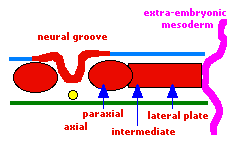 |
| Segmentation of the paraxial mesoderm into somites
continues caudally at 1 somite/90minutes and a cavity (intraembryonic
coelom) forms in the lateral plate mesoderm separating somatic and
splanchnic mesoderm. Note: intraembryonic coelomic cavity communicates with extraembryonic coelom through portals (holes) initially on lateral margin of embryonic disc. |
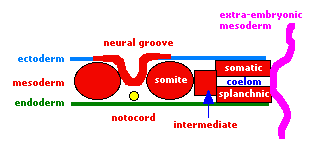 |
| Somites continue to form. The neural groove fuses dorsally to form a tube at the level of the 4th somite and "zips up cranially and caudally and the neural crest migrates into the mesoderm. | 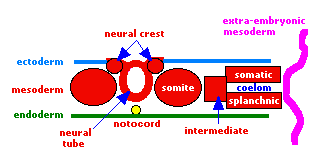 |
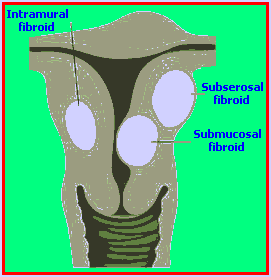
Three primary types of uterine fibroids (tumors):
- Subserosal fibroids, which develop under the outside covering of the uterus and expand outward through the wall, giving the uterus a knobby appearance. They typically do not affect a woman's menstrual flow, but can cause pelvic pain, back pain and generalized pressure. The subserosal fibroid can develop a stalk or stem-like base, making it difficult to distinguish from an ovarian mass. These are called pedunculated. The correct diagnosis can be made with either an ultrasound or magnetic resonance (MR) exam.
- Intramural fibroids, which develop within the lining of the uterus and expand inward, increasing the size of the uterus, and making it feel larger than normal in a gynecologic internal exam. These are the most common fibroids. Intramural fibroids can result in heavier menstrual bleeding and pelvic pain, back pain or the generalized pressure that many women experience.
- Submucosal fibroids, which are just under the lining of the uterus.& These are the least common fibroids, but they tend to cause the most problems. Even a very small submucosal fibroid can cause heavy bleeding — gushing, very heavy and prolonged periods.
3 noted types of female sexual response during coitus:
- Similar in many ways to that of
male, as sexual arousal- Engorgement- (swelling with blood) of erectile
tissues in
- the clitoris ( erogenous sensitivity), and
- vestibular bulbs ( sexual stimulation for both partners through tightening of vaginal opening around penis) - Secretion of
lubricating fluids- from vestibular glands,vaginal wall & cervix,
also due to blood flow
- easier penetration & movement of penis in vagina
sexual stimulation through resulting massaging action - Orgasm, with peak of sensation, rhythmic contractions of bulbospongiosus muscle (skeletal) and smooth muscle (e.g., uterus), then wider opening of cervix for ~30’ along with deep general relaxation; if sexual stimulation continues, females may experience multiple orgasms without intervening latent period of the male.
3 animal species in which SARS (Severe Acute Respiratory Syndrome virus has been found in China:
- Palm civets — a cat-size animal that is served as food.
- Raccoon dog.
- Badger.
Source: New York Times 05-2-03 article by Keith Bradsher with Lawrence K. Altman "Strain of SARS Is Found in 3 Animal Species in Asia"
3 considerations offered as the reason for this report:
- To conceal the real culprit(s): Government/Corporate/Terrorist virus testing on human population.
- To curtail primitive "traditional" practices of eating certain foods that are felt to interfere with government attempts to modernize a population.
- To stop the hunting and butchering of species which are threatened by extinction.
3 main areas on Earth where SARS has been reported: Asia ~ North America ~ Europe.
Three important responsibilities of the placenta:
- Nutrition of the embryo.
- Gaseous exchange.
- Excretion.
Three phases exhibited by the FD bacteriophage (virus):
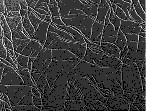
- Cholesteric phase
- Smectic phase
- Twist Grain Boundary Phase.
FD virus has been used to explore interesting phases such as:
- Rod Sphere Mixtures
- Isotropic-Smectic coexisting as a result of adding attraction inducing Polymers
- Nematic Angular Distribution Function
The Fd is a virus that infects certain strains of Escherichia Coli bacteria. It is not dangerous to people. The virus is about 880 nm in length and 6.6 nm in diameter. The protein shell has a hollow core in the center into which the DNA is stuffed.
Updated Posting (HTML maintenance): Sunday, 15th September 2019... 2:03 PM
Latest Update: Friday, February 24th, 2023... 11:39 AM
Herb O. Buckland
herbobuckland@hotmail.com